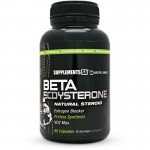By Anthoney J. Andersen – Sterodial.com
When you’re outdoors this summer – whether at the beach or sitting poolside with an ice cold beer – think about your vitamin D intake.
Often coined the “sunshine vitamin” – because it’s absorbed through the skin by sunlight – vitamin D is a fat-soluble vitamin in a family of compounds that includes vitamin D1, D2 and D3, according to Healthline.com
Vitamin D can affect as many as 2,000 genes in the human body.
Let’s take a closer look as to why this vitamin is so vital to our everyday health.
HEALTH BENEFITS
Vitamin D has several important roles in the human body. Perhaps the most vital role vitamin D plays is regulating the absorption of calcium and phosphorous, while simplifying normal immune function.
Calcium regulation is extremely important, especially as we get older. As we age, our bodies absorb less and less calcium, which can cause our bones to become weak and brittle.
“If you have a vitamin D deficiency, particularly in your later years, it can lead to osteoporosis or osteomalacia (bone softening),” says Lona Sandon, RD, assistant professor of clinical nutrition at the University of Texas Southwestern in Dallas.
Our bones also store calcium in addition to providing support for our bodies.
With the help of vitamin D – which we obtain from the foods we eat and from our skin in response to sunlight – it can assist in promoting absorption from our intestines, and help build and maintain stronger bones.
VITAMIN D BATTLES DISEASE
In addition to maintaining strong bones and teeth, vitamin D also helps stave off certain diseases:
- Vitamin D can reduce the risk of multiple sclerosis, according to a 2006 study published in the Journal of the American Medical Association.
- It can lessen your chance of developing heart disease, according to 2008 findings published in Circulation.
- It can help reduce the likelihood of developing the flu, according to 2010 research published in American Journal of Clinical Nutrition.
HOW MUCH IS ENOUGH?
An average healthy adult between the ages of 19 and 50 should intake roughly 200 IU’s of vitamin D.
Older adults should look to consume higher levels in order to ensure proper bone maintenance. According to Mayo Clinic, recommendations for adults ages 51 to 70 is around 400 IU, and individuals over 70 should receive 600 IU a day.
SOURCES OF VITAMIN D
As mentioned earlier, vitamin D is naturally produced in the human body when exposed to sunlight.
Limited sun exposure has been the leading cause of vitamin D deficiency, according to the Centers for Disease Control and Prevention (CDC).
A tiny amount can go a long way: just 10 minutes of mid-day sun exposure is plenty – especially if you’re fair-skinned.
Unfortunately, very few foods naturally contain vitamin D. As a result, many foods are fortified with the vitamin – meaning that vitamins have been added to the foods.
Fatty fish, such as tuna, salmon and mackerel, are among the best sources of vitamin D, according to MedlinePlus.com.
Beef liver, cheese and egg yolks are also considered good sources of vitamin D. However, they contain only small amounts in comparison to the different kinds of fatty fish.
Most milk in the United States has been fortified to contain 400 IU of vitamin D per quart, according to the CDC.
Keep me mind, however, that foods made from milk – cheese and ice cream for example – are often not fortified.
Since it can be difficult to achieve the recommended amount of vitamin D, a lot of people turn to vitamin D supplements to help close the gap.
BE WARY OF “D-FICIENCY”
Many factors can contribute to the lack of vitamin D your body receives: lifestyle and environmental factors for instance, can decrease your body’s chances of receiving the proper amount of vitamin D from the sunlight.
These factors may include:
- Pollution.
- Use of sunscreen.
- Spending more time indoors.
- Working longer hours in offices.
- Living in big cities where buildings block sunlight.
These factors have been known to cause vitamin D deficiency in an increasing number of people. That’s why it’s vital not to rely solely on sunlight as your only source of vitamin D.
CONCLUSION
Like with most vitamins, vitamin D is an essential nutrient to maintaining a healthy life.
The National Institute of Health (NIH) reports that a person can take as high as 2,000 IU per day, without it becoming toxic to the body.
So, if you think you’re not meeting the daily recommended dosage of vitamin D, and you want to learn more about what you can do to change this, consult your doctor for guidance to ensure you get the proper amount for your needs.
Take action.
Medical References:
1.] “Serum 25-hydroxy Vitamin D levels and Risk of Multiple Sclerosis.” 2006. Dec. 20. Journal of the American Medical Association.
2.] “Vitamin D Deficiency and Risk of Cardiovascular Disease.” 2008. Jan. 29. Circulation.
3.] “Randomized Trial of Vitamin D Supplementation to Prevent Seasonal Influenza.” 2010. May. 9. American Journal of Clinical Nutrition.







